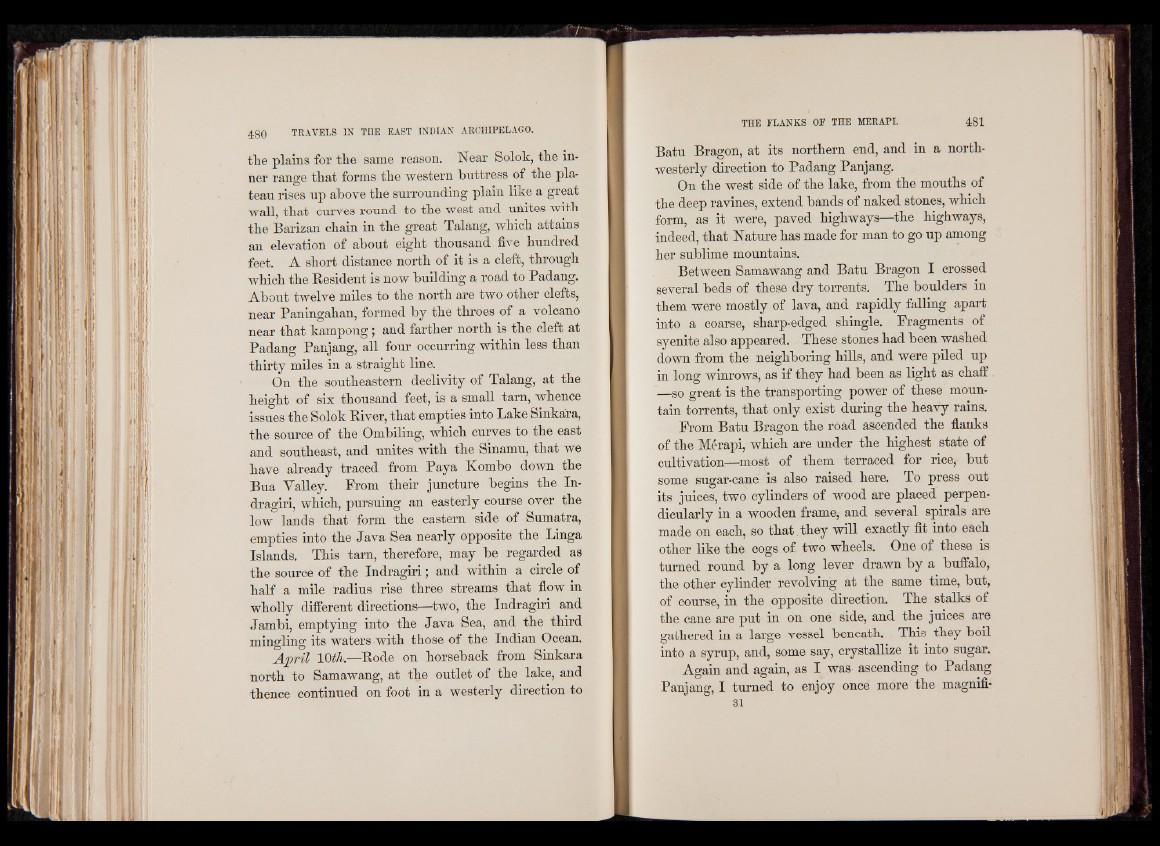
the plains for the same reason. Near Solok, the inner
range that forms the western buttress of the plateau
rises up above the surrounding plain like a great
wall, that curves round to the west and unites with
the Barizan chain in the great Talang, which attains
an elevation of about eight thousand five hundred
feet. A short distance north of it is a cleft, through
which the Resident is now building a road to Padang.
About twelve miles to the north are two other clefts,
near Paningahan, formed by the throes of a volcano
near that kampong; and farther north is the cleft at
Padang Panjang, all four occurring within less than
thirty miles in a straight line.
On the southeastern declivity of Talang, at the
height of six thousand feet, is a small tarn, whence
issues the Solok River, that empties into Lake Sinkara,
the source of the Ombiling, which curves to the east
and southeast, and unites with the Sinamu, that we
have already traced from Paya Kombo down the
Bua Valley. From their juncture begins the In-
dragiri, which, pursuing an easterly course over the
low lands that form the eastern side of Sumatra,
empties into the Java Sea nearly opposite the Linga
Islands. This tarn, therefore, may be regarded as
the source of the Indragiri; and within a circle of
half a mile radius rise three streams that flow in
wholly different directions—two, the Indragiri and
Jambi, emptying into the Java Sea, and the third
mingling its waters with those of the Indian Ocean.
A p ril 10th.—Rode on horseback from Sinkara
north to Samawang, at the outlet of the lake, and
thence continued on foot in a westerly direction to
Batu Bragon, at its northern end, and in a northwesterly
direction to Padang Panjang.
On the west side of the lake, from the mouths of
the deep ravines, extend bands of naked stones, which
form, as it were, paved highways—the highways,
indeed, that Nature has made for man to go up among
her sublime mountains.
Between Samawang and Batu Bragon I crossed
several beds of these dry torrents. The boulders in
them were mostly of lava, and rapidly falling apart
into a coarse, sharp-edged shingle. Fragments of.
syenite also appeared. These stones had been washed
down from the neighboring hills, and were piled up
in long winrows, as if they had been as light as chaff
—so great is the transporting power of these mountain
torrents, that only exist during the heavy rains.
From Batu Bragon the road ascended the flanks
of the Merapi, which are under the highest state of
cultivation—most of them terraced for rice, but
some sugar-cane is also raised here. To press out
its juices, two cylinders of wood are placed perpendicularly
in a wooden frame, and several spirals are
made on each, so th a t. they will exactly fit into each
other like the cogs of two wheels. One of these is
turned round by a long lever drawn by a buffalo,
the other cylinder revolving at the same time, but,
of course, in the opposite direction. The stalks of
the cane are put in on one side, and the juices are
gathered in a large vessel beneath. This they boil
into a syrup, and, some say, crystallize it into sugar.
Again and again, as I was ascending to Padang
Panjang, I turned to enjoy once more the magnifi-
31